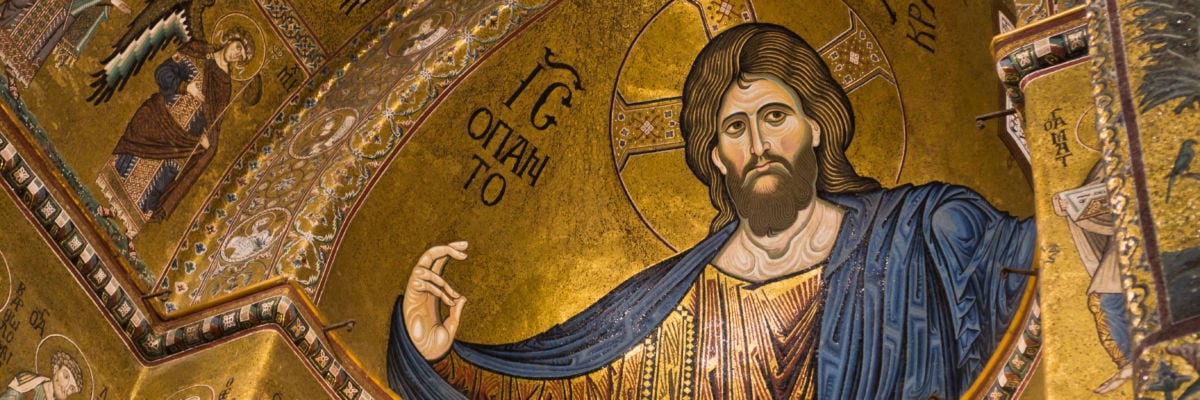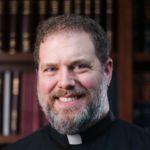
It’s not unusual for the Old Testament and the Gospel to match up at Mass. This is part of the point of the lectionary: to bring these connections to our view. Though it’s not quite as often that we see this level of parallel in what is often called the “summary of the law.”
For us (in the Ordinariate form), hearing it at the beginning of Mass, we’ve now heard this summary three times. Jesus, in giving it, neatly sums up the law and the prophets, as the scholar in Mark notes. Catholic tradition likewise associates these two laws with the two tables of the Decalogue and the two types of petitions in the Our Father—those directed to God and those directed to our neighbor.
But what about our lesson from Hebrews? We have, perhaps you’ve noticed, been walking through Hebrews in the lectionary over the last several weeks. And it is not immediately clear how this passage about the Levitical high priesthood is relevant to the sandwich passages summing up the Law and the Prophets. According to Hebrews, the old high priesthood was limited because the high priests did not live forever—not like Jesus, that is. The old high priests also had to offer sacrifices for themselves before they offered atonement for the people. Jesus does not have to do this, being himself completely holy and innocent. The author ends this passage with this statement: “The law appoints men in their weakness as high priests, but the word of the oath, which came later than the law, appoints a Son who has been made perfect for ever” (7:28).
The oath mentioned is what we heard in Hebrews last week, a quotation from the psalm saying, “Thou art a priest forever, after the order of Melchisedech.” We hear reference to Melchisedech at almost every Mass, at least if the Roman canon is used, because, in the imagination of the early Church, Melchisedech was this mysterious figure from the book of Genesis, at times thought to be an actual appearance of the pre-incarnate Christ, to whose priesthood Abraham submitted. And any Catholic can recognize the astonishing imagery of an ancient priest, thousands of years before the institution of the Eucharist, offering bread and wine on an altar before God. Hebrews, in fact, mulls on this mysteriousness and makes much of it; we do not know who Melchisedech was, just as no one knew who Christ was, at least at first. He was not born of a royal house; he was not a prominent person. Yet he appears, seemingly out of nowhere, performing a priestly ministry like no other.
For Hebrews, Christ is uniquely superior to the old priests because his sacrifice is both permanent and complete. Unlike the old priests, who sacrifice bulls and goats, Christ offers himself. But his self—his bodily offering on the cross—is of infinite value, because of his human perfection and his divine nature. His sacrifice transforms the whole concept of sacrifice. In light of him, no other sacrifice has any meaning. In light of him, all sacrifices have meaning. Both of these things are true.
What does any of this have to do with the summary of the law in Deuteronomy and Mark? Just this: In Jesus, God and neighbor are one. If we are to love God with our whole heart, mind, and strength, and to love our neighbor as ourself, Jesus is both God and our neighbor. And although the two commandments remain relevant and binding in every human situation, the point of Hebrews seems to be that all of those other situations are subject to this primary relationship with the one who is both God and man—both priest and victim. It is only through Jesus that we can fully understand what it means to love both God and neighbor. He himself is the summary of the Law and the Prophets.
I say the Missal’s Votive Mass of the Sacred Heart whenever I can, partly because I’m always cut to the quick by the powerful words of its proper preface, which points out how the Father willed the heart of the Son to be pierced by a spear so “that his heart, manifest as the shrine of thy heavenly bounty, might pour fourth for us floods of grace and of compassion, and that, since it hath never ceased to burn for us with ardent longing, it might be the resting place of them that love thee, and the ever-open refuge of safety for the penitent.” I can’t help returning to those words again and again. Maybe it is because, as Pope Francis writes in his new encyclical Dilexit Nos, the Sacred Heart “is the unifying principle of all reality” (31). This week in particular, while we do our civic duty at the polls, we do well to remember that the ultimate outcome of history depends not on who does or doesn’t win an election, but on the outpouring of divine love made known to us some two thousand years ago.
If we want to love God with all our heart, we can look nowhere better than the heart of Jesus. If we want to love our neighbor as ourselves, we can look nowhere better than the heart of Jesus. He is the perfection of all loves. Again I turn to the Holy Father’s new encyclical, which itself quotes Pope Pius XII in claiming for the Sacred Heart a unity among three distinct loves: “First, we contemplate his infinite divine love. Then our thoughts turn to the spiritual dimension of his humanity, in which the heart is ‘the symbol of that most ardent love which, infused into his soul, enriches his human will.’ Finally, ‘it is a symbol also of his sensible love’” (65).
The practical meaning is this: we can pose no artificial division or separation between the spiritual and corporal works of mercy, or between personal acts of piety and communal acts of charity. Loving Jesus in the sacrament shows itself false when I show no love for the poor. Loving Jesus in the poor shows itself false when I show no love for the Church. Though when we do these things with sincerity and truth, they imply the other. Not everyone who spends hours in adoration will also spend hours in the soup kitchen. Not everyone who spends hours in service or public witness will also spend hours in quiet contemplation. Martha needs Mary, and Mary needs Martha.
But the center of all things is Jesus. Whatever we do, whether contemplative or active, spiritual or corporal, has to be in union with him and his body—which is not an abstraction, but the real presence of the faithful here and now as well as the real presence of the precious body and blood on our altars. When we pray for unity in the Church, it is not just a superficial togetherness, but a common witness and commitment to embodying the Law and the Prophets, which have already been embodied, and suffered, and died, and resurrected, in our Lord Jesus Christ.
As we enter this season of remembering the saints, as well as all the faithful departed, we pray that we will ourselves be re-membered into the body of Christ—made one with the Law and the Prophets, loving both God and neighbor, both for our own salvation and that of the whole world. Amen.



